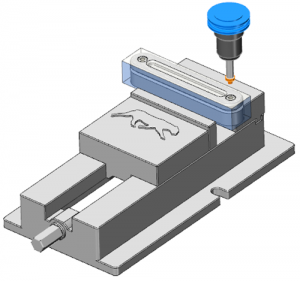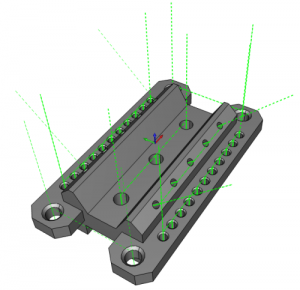Tech Tuesday is a weekly blog that addresses some of the most common questions and concerns that I hear throughout the previous week from users of BobCAD-CAM software. Both customers and future customers are more than welcome to leave a comment on what they would like to see covered for the following Tech Tuesday. Enjoy!
Making holes is a common, everyday task for most machine shops. It seems no matter what type of part you are working with to create holes, drilling and tapping cycles are most likely to be utilized.
So how does BobCAD-CAM’s CNC software make programming these holes easier? We have a simple trick; reusing your hole features from recent projects for future projects.

So, what’s a hole feature you ask? In the BobCAD system, we use features to create Toolpath. Features are based on Toolpath categories, like drilling, tapping, counterbore, etc… A feature can contain multiple Toolpaths and tools to “process” holes or other shapes.
For example, when programming a typical tapped hole, you’ll need to spot the hole location, drill the hole to size and then tap the hole. In many CAM software packages, each one of these steps is done separately. Using BobCAD’s Feature Hole Cycle, users can combine multiple tools and cycle to “process” the hole at one time. This method of programming makes it faster to program because you’re getting more done in fewer steps.
Subscribe to BobCAD-CAM's Tech Tuesday Blog
Join your fellow machinists. Get the latest Tech Tuesday CAD-CAM articles sent to your inbox. Enter your email below:
Additionally, BobCAD users can save & load or copy and past these features into different part setup locations, index systems or new projects. By saving information like speeds & feeds and depth of cut, users can reuse these hole features, saving them a great amount of time. “Our customers want easy to use features that do not require special programming knowledge to set up an use,” says Bob Twaalfhoven, Founder of BobCAD-CAM software.

As you probably know, the reason for CAD-CAM software is to automate and streamline the programming process. Some systems use feature recognition technology to process holes automatically, which, conceptually, sound great doesn’t it? What most vendors won’t talk about is the “cutting conditions” that those hole cycles are based on can be difficult or impossible to set up and customize for the way your shop would typically program them.
Which is why BobCAD’s saving & loading and copy & pasting of hole features makes it easy for anyone to speed up their programming. After creating the Toolpath for a tapped hole, users can copy that hole feature into a new setup, index system or even a new project. By reusing the hole features you know works in your shop, you can shave many hours of part programming time off of your workload. Now that you’re not getting bogged down with redundant programming tasks, what will you do with all that extra time? Thank you so much for reading another Tech Tuesday; see you next week!
Start your Test Drive.
Have questions? Call us at 877-838-1275.
You’re one click away from subscribing to BobCAD’s YouTube channel. Click the link below for tips, how-tos and much more!
To see if BobCAD’s Mill Turn software is right for your shop,
Summary
Article Name
Tech Tuesday: Drilling & Tapping Workflow To Speed Up Part Programming in CAM Software
Description
Making holes is a common, everyday task for most machine shops. It seems no matter what type of part you are working with to create holes, drilling and tapping cycles are most likely to be utilized.
So how does BobCAD-CAM’s CNC software make programming these holes easier? We have a simple trick; reusing your hole features from recent projects for future projects.
Author
Michael A. Downss
BobCAD-CAM Software